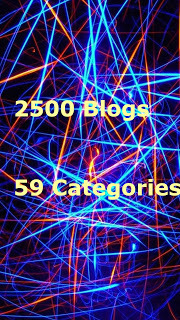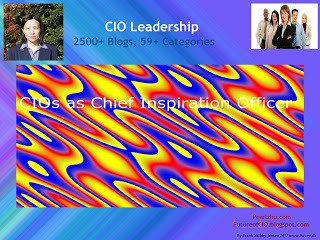Pearl Zhu's Blog, page 1370
January 21, 2016
Three Questions to Assess an Employee’s Brightness
People with true brightness brighten the world.
 The majority of us like brightness and fear darkness, because the brightness reminds us of the sunshine, love, and optimism. Can we qualify and quantify brightness? When we compliment someone bright, does it more refer to physical healthiness, intellectual smartness, or spiritual maturity? Do extroverts look brighter than introverts because it seems they are more visible, talkative, more prone to action than contemplation, and generally show warm interest in their surroundings? What are the good questions to assess an employee’s brightness?
The majority of us like brightness and fear darkness, because the brightness reminds us of the sunshine, love, and optimism. Can we qualify and quantify brightness? When we compliment someone bright, does it more refer to physical healthiness, intellectual smartness, or spiritual maturity? Do extroverts look brighter than introverts because it seems they are more visible, talkative, more prone to action than contemplation, and generally show warm interest in their surroundings? What are the good questions to assess an employee’s brightness?
Which color is your Aura? The Aura is the energy bag that surrounds the whole body of the individual, and it is the seat of all emotions. We feel we create a kind of vibration around us. That enthusiasm, energy, optimism, and love oozes out our bodies. It’s starting point of experience is from within. There is a natural aura of Nature abundantly outside for all of us, we, however, can experience it, only if we really feel so, have such a touch within us. There is also another aspect of the auric field: the COLOR. The thought forms being given out by a personality are reflected in shapes and colors and that is all within their aura as well. People who can see auras can sense a person's nature or where they are coming from by the colors surrounding them. Your self-confidence, bravery, commitment, and determination etc, all form as an aura around you when you strongly believe in your strengths. The more worry about our weaknesses turns as a negative aura! Therefore, often the bright people are often more optimistic and confident. Optimism is an outward view to see the bright side of the things; while positive is an internal mental attitude to achieve a better result. When we find calm inside, we sense the aura outside too.
Imagine if you were a magnet, what kind of people would you attract to? The best and brightest, or the opposite? Do you just look bright, or you often think the bright side as well? Are you always open minded or often hold some hidden agenda? Can you always brighten the surroundings, because of your positive emotions and optimistic attitude? Or dim down the working environment because of too much shadow in the mind or let negative emotions such as envy, hatred, greed, self-indulgence, selfishness, back-biting, rumor-mongering flow around. “Being bright” is the view look for the best, come with a positive mentality, your behavior, the way you showcase your attitude and mood others to put on their thinking cap. Being positive is within yourself, reflects your personality, thought process put into action. People with great auras can attract others to them since most have wisdom, power and love exuding from their energetic bodies.
 Intellectually, is your brightness based on smartness, intelligence or wisdom? Perhaps the first impression of the “brightness” is based on the outlook of “smartness,” but the long-lasting brightness is based on multidimensional intelligence and profound wisdom. Just like the brightest colors are not always flashy, the brightest person is not always the most visible one as well. and A brighter mind is magnetic to attract even “polar opposite” viewpoint as every wise thought always has opposite thought not less wise. A brighter person may not always be “outgoing,” and a truly bright mind is equipped with wisdom, and wisdom is driven by a central logic that can be considered value judgment, intellectual maturity, universal love, thoughtfulness - considers consequences of one’s actions in regards to others.
Intellectually, is your brightness based on smartness, intelligence or wisdom? Perhaps the first impression of the “brightness” is based on the outlook of “smartness,” but the long-lasting brightness is based on multidimensional intelligence and profound wisdom. Just like the brightest colors are not always flashy, the brightest person is not always the most visible one as well. and A brighter mind is magnetic to attract even “polar opposite” viewpoint as every wise thought always has opposite thought not less wise. A brighter person may not always be “outgoing,” and a truly bright mind is equipped with wisdom, and wisdom is driven by a central logic that can be considered value judgment, intellectual maturity, universal love, thoughtfulness - considers consequences of one’s actions in regards to others.
The bright people with the positive mindset can brighten the surroundings and become the change agent to overcome the shadows in people’s mind, build the culture of learning and innovation. The brightness takes energy, and needs to be charged with intelligence and wisdom, and wisdom comes from the experience of intelligence whether it be exterior or interior. People with true brightness brighten the world.
Follow us at: @Pearl_Zhu
 The majority of us like brightness and fear darkness, because the brightness reminds us of the sunshine, love, and optimism. Can we qualify and quantify brightness? When we compliment someone bright, does it more refer to physical healthiness, intellectual smartness, or spiritual maturity? Do extroverts look brighter than introverts because it seems they are more visible, talkative, more prone to action than contemplation, and generally show warm interest in their surroundings? What are the good questions to assess an employee’s brightness?
The majority of us like brightness and fear darkness, because the brightness reminds us of the sunshine, love, and optimism. Can we qualify and quantify brightness? When we compliment someone bright, does it more refer to physical healthiness, intellectual smartness, or spiritual maturity? Do extroverts look brighter than introverts because it seems they are more visible, talkative, more prone to action than contemplation, and generally show warm interest in their surroundings? What are the good questions to assess an employee’s brightness?
Which color is your Aura? The Aura is the energy bag that surrounds the whole body of the individual, and it is the seat of all emotions. We feel we create a kind of vibration around us. That enthusiasm, energy, optimism, and love oozes out our bodies. It’s starting point of experience is from within. There is a natural aura of Nature abundantly outside for all of us, we, however, can experience it, only if we really feel so, have such a touch within us. There is also another aspect of the auric field: the COLOR. The thought forms being given out by a personality are reflected in shapes and colors and that is all within their aura as well. People who can see auras can sense a person's nature or where they are coming from by the colors surrounding them. Your self-confidence, bravery, commitment, and determination etc, all form as an aura around you when you strongly believe in your strengths. The more worry about our weaknesses turns as a negative aura! Therefore, often the bright people are often more optimistic and confident. Optimism is an outward view to see the bright side of the things; while positive is an internal mental attitude to achieve a better result. When we find calm inside, we sense the aura outside too.
Imagine if you were a magnet, what kind of people would you attract to? The best and brightest, or the opposite? Do you just look bright, or you often think the bright side as well? Are you always open minded or often hold some hidden agenda? Can you always brighten the surroundings, because of your positive emotions and optimistic attitude? Or dim down the working environment because of too much shadow in the mind or let negative emotions such as envy, hatred, greed, self-indulgence, selfishness, back-biting, rumor-mongering flow around. “Being bright” is the view look for the best, come with a positive mentality, your behavior, the way you showcase your attitude and mood others to put on their thinking cap. Being positive is within yourself, reflects your personality, thought process put into action. People with great auras can attract others to them since most have wisdom, power and love exuding from their energetic bodies.
 Intellectually, is your brightness based on smartness, intelligence or wisdom? Perhaps the first impression of the “brightness” is based on the outlook of “smartness,” but the long-lasting brightness is based on multidimensional intelligence and profound wisdom. Just like the brightest colors are not always flashy, the brightest person is not always the most visible one as well. and A brighter mind is magnetic to attract even “polar opposite” viewpoint as every wise thought always has opposite thought not less wise. A brighter person may not always be “outgoing,” and a truly bright mind is equipped with wisdom, and wisdom is driven by a central logic that can be considered value judgment, intellectual maturity, universal love, thoughtfulness - considers consequences of one’s actions in regards to others.
Intellectually, is your brightness based on smartness, intelligence or wisdom? Perhaps the first impression of the “brightness” is based on the outlook of “smartness,” but the long-lasting brightness is based on multidimensional intelligence and profound wisdom. Just like the brightest colors are not always flashy, the brightest person is not always the most visible one as well. and A brighter mind is magnetic to attract even “polar opposite” viewpoint as every wise thought always has opposite thought not less wise. A brighter person may not always be “outgoing,” and a truly bright mind is equipped with wisdom, and wisdom is driven by a central logic that can be considered value judgment, intellectual maturity, universal love, thoughtfulness - considers consequences of one’s actions in regards to others.
The bright people with the positive mindset can brighten the surroundings and become the change agent to overcome the shadows in people’s mind, build the culture of learning and innovation. The brightness takes energy, and needs to be charged with intelligence and wisdom, and wisdom comes from the experience of intelligence whether it be exterior or interior. People with true brightness brighten the world.
Follow us at: @Pearl_Zhu
Published on January 21, 2016 23:20
Digital IT Maturity
 Digital means business. Digital IT should add more strategic advantage. IT strategy is an integral component of business strategy, as more often than not, technology is the driver for business innovation. The trend of IT consumerization indeed provides unprecedented opportunities for IT to get more touch base with end customers, and empower employees as well, IT acts more as an ‘orchestrator,’ to conduct an information-mature, customer-centric digital organizations, and IT maturity directly makes an impact on the organizational maturity.
Digital means business. Digital IT should add more strategic advantage. IT strategy is an integral component of business strategy, as more often than not, technology is the driver for business innovation. The trend of IT consumerization indeed provides unprecedented opportunities for IT to get more touch base with end customers, and empower employees as well, IT acts more as an ‘orchestrator,’ to conduct an information-mature, customer-centric digital organizations, and IT maturity directly makes an impact on the organizational maturity.
Digital Transformer: Information Technology should be seen by any business as a “digital transformer” and strategy enabler. It is a significant part of the business strategy, and not simply as a tool or mechanism to support business goals. There are very few businesses today can state that IT does not play a significant role in the day to day operations or even long-term strategic positioning. Hence, organizations need to take that into consideration when establishing strategic goals to manage their digital transformation. Further, IT department should not live in a silo, or a function running as a help desk and support center only. Both strategic and tactical objectives should be set to achieve the digital strategy and business objectives, these are then broken into objectives for the department. The CIO should sit on the executive board, not because IT is important, but because it is business critical that the CIO and the IT department effectively enables and facilitates the business strategy and objectives, and ultimately digital transformation. To effectively “support” business strategic execution, IT must sit at the table as a business line and be a key player in the development of business strategy before execution.
Digital synchronization: Both business and IT get synchronized to stay at the same page about business strategy, and weave IT into business strategy and execution. It is about Information Management coherence. In order to build a bridge between IT and business, there must be a very clear understanding and agreement between IT and the business about the role of IT in the organization. If the business only regards IT as a support function, then the priority will be operational efficiency, closing the gap is about doing the basics right to synchronize business and IT and orchestrate digital symphony. If the business expects IT to be a driver of innovation and change, then the IT function needs to be flexible and responsive and even proactive to synchronize with core business activities. The business needs to know what IT can deliver and enter a dialogue about what best serves the goals of the business. IT needs to be telling business about the opportunities and possibilities and that means IT needs to really understand the goals of the business and synchronize with business goals. Ultimately you'd want to recognize that what most businesses need is an IT capability which is the key component of building business capability, not "just" an IT department. Framing the right problem and, therefore, framing the problem right, it’s often about digital business synchronization, alignment, and implementation.
Digital Balance: We have more computing power, greater connectivity, more data, greater potential empowerment of the worker, etc. But more of something isn't always necessarily good. Digital IT has faster speed. The pervasive digitalization or IT consumerism require the balance of “old experience” and “new way to do things,” the “learning and doing.” Keep the balance of IT stability and speed. Technology Enablement is always about planning, funding, designing, building, operating, securing, optimizing and balancing. There are a few things that are different from 'business as usual.' First, pervasive digitization requires both business and technology professionals to rethink how things are done in organizations. The 'reach and range' flexibility that now exists removes barriers that have existed in the past. Second, business professionals are not infrequently 'ahead' of their organization's technology professionals when it comes to thinking about the opportunities made available by pervasive digitization (what some technology pundits refer to as 'IT consumerism.') Third, media and platform choices will matter more than ever with an increasing ease of translating content across media types and the ease of migrating across platforms. How this cornucopia of design options is exploited and managed thus becomes a crucial factor in an organization's success in producing digitized products and services. Finally, the emergence of potential opportunities for exploiting digitization is likely to follow a nonlinear pattern or exponential speed, as the pervasiveness of an organization's digitization journey increases. How these ideas are recognized, filtered and dealt with a will as well become a crucial factor in an organization's success in running a balanced IT and producing digitized products and services
Digital Innovation: From an innovation perspective, IT mantra is shifting from “doing more with less,” to “doing more with innovation.” However, running an innovative IT doesn't mean IT will go “wild,” or "rogue," IT should also go smarter and flexible; it doesn't mean IT should get rid of all those processes or IT framework hassles. In fact, creativity and process have to go hand in hand; without process there is chaos and from the chaos it’s hard to be creative. Using both modes-creativity and IT framework to be successful; that could sound like a contraction. But actually you need to run IT with two modes: the systematic approach with IT framework to achieve the benefits of industrializing certain domains of activity such as service management, Infrastructure management etc. the digital shift for IT in some industries is to be innovative with systems of engagement rather than systems of record. The available digital technology just makes innovation easier to do now than in the past - less costly, more easily accessible.
 Digital Fit: Achieving efficiency is always one of the important goals to improve the bottom line. IT needs to prune “the weed” regularly. The approach to “keep fit” is to implement a program that like a gardener would prune the tree and nurture the valuable solutions. Pruning the weeds would face resistance, however, at the end of the day, this was not just an IT decision and rather than let the senior management team beat them up, by understanding and communicating the actual costs, the senior management team could be pointed in other directions as IT is simply delivering the decisions of their business. IT needs to promote its products and market its capabilities. IT departments have to sell the benefits of their solutions or the IT enabled business capabilities and competency not just once but.In reality, managing multiple people, projects, and timelines are more like the Spinning Plates act. Usually, projects are launched at different times, sometimes in synergy with existing programs, and tended to have at varying degrees of focus (the spin) to keep them going, so they don't fall off the pole. Thus, the best leaders will optimize each person's ability to handle the "plate load" effectively, all with the brand quality and emphasis on progress and delivery. The sooner you finish your existing commitments, the sooner you can launch new projects, whether your own idea that is successfully lobbied for resources or another that were pending, awaiting someone to manage it to completion. The spinning plates are one aspect of multiple projects.
Digital Fit: Achieving efficiency is always one of the important goals to improve the bottom line. IT needs to prune “the weed” regularly. The approach to “keep fit” is to implement a program that like a gardener would prune the tree and nurture the valuable solutions. Pruning the weeds would face resistance, however, at the end of the day, this was not just an IT decision and rather than let the senior management team beat them up, by understanding and communicating the actual costs, the senior management team could be pointed in other directions as IT is simply delivering the decisions of their business. IT needs to promote its products and market its capabilities. IT departments have to sell the benefits of their solutions or the IT enabled business capabilities and competency not just once but.In reality, managing multiple people, projects, and timelines are more like the Spinning Plates act. Usually, projects are launched at different times, sometimes in synergy with existing programs, and tended to have at varying degrees of focus (the spin) to keep them going, so they don't fall off the pole. Thus, the best leaders will optimize each person's ability to handle the "plate load" effectively, all with the brand quality and emphasis on progress and delivery. The sooner you finish your existing commitments, the sooner you can launch new projects, whether your own idea that is successfully lobbied for resources or another that were pending, awaiting someone to manage it to completion. The spinning plates are one aspect of multiple projects. Both fast growing business and well-established organization set top priorities to build new capabilities in which IT is a key enabler. IT needs to be the driver for the business's digital transformation. IT needs to build both strategy and practices to transform into digitalization. Do not underestimates the perfect wave of combined integration of all of the exponential growth curves. The forward-looking organizations always continue to learn and strike the right balance between “old” and “new” way to do things. IT-business alignment is moving into IT enablement and IT engagement in order to improve IT agility and maturity. Follow us at: @Pearl_Zhu
Published on January 21, 2016 23:15
January 20, 2016
The Monthly Strategy Highlight: Debunk the Myths of Digital Strategy Management Jan.2016
The strategy is the light to guide you ahead, not the hand to walk you through.
 The “Future of CIO” Blog has reached 1.3 million page views with 2500+ blog posting in 59+ different categories of leadership, management, strategy, digitalization, change/talent, etc. blog posting. The content richness is not for its own sake, but to convey the vision and share the wisdom.
The “Future of CIO” Blog has reached 1.3 million page views with 2500+ blog posting in 59+ different categories of leadership, management, strategy, digitalization, change/talent, etc. blog posting. The content richness is not for its own sake, but to convey the vision and share the wisdom.
A digital strategy is cross-functional effort and multidisciplinary, multidimensional planning; it brings up new functions, roles, and responsibilities, collaboration, demand for intuition and emergence, complementarities, philosophy, neutron sciences, and trans-disciplinary businesses. But these are not new per se. The frameworks of thoughts, consciousness and maturity assessments apply to strategy, then, now and in the future. Here is the first monthly strategy highlight of the “Future of CIO” blog in 2016.
Debunk the Myths of Digital Strategy Management Jan. 2016Three Insights in Digital Strategy Management: Nowadays, with increasing speed of change and fierce competition, business strategy execution is no longer linear steps, but a dynamic continuum. If strategy formulation is more important for leading business toward the right direction, then strategy execution is perhaps more difficult due to the business complexity, uncertainty, time/resource consuming, etc. The strategic themes are essentially the pillars of the organization. They include business growth, operational excellence, customer experience excellence, product development, innovation, and sustainability. Strategic perspectives include financial aspect, customers and stakeholders' aspect, internal processes, organizational capability and engaged leadership. Strategy execution: How difficult could it be?
Three Characteristics of Digital Strategy Digital strategy planning is a living process, and a good strategy is not “superficial,” it needs to dig deeper and diagnose the root causes of emergent business issues, because digital organization is a part of the dynamic business ecosystem that connects digital dots or resources inside and outside of the organization to create values for customers. So the piecemeal strategy of bolting digital channels to the business is no longer sufficient, and digital strategy needs to be shifted from top-down one-way direction to organizational inclusion, from static and linear strategy-execution scenario to dynamic strategy execution continuum; from a single strategy documentation often put on the shelf to an ongoing strategy portfolio. More specifically, what are the characteristics of an executable digital strategy?
Culture vs. Strategy: Which Comes First?: The strategy is like the business roadmap to leverage the company's resources and achieve its vision; and culture is the collective mindset, attitude, and behaviors of the group of people and it's about how people think and do things here. Many of us like Drucker's witty quote, “Culture eats strategy for breakfast.” A strong culture can lift up a mediocre strategy, but a weak or negative culture will screw a superior strategy. So culture vs. strategy: which comes first? And what are the interwoven relationship between them?
The Pros and Cons of SWOT Analysis for Digital Organization. The digital world is complex and uncertain, the world boundaries close in, business weaknesses and strengths are inseparable, opportunities are tightly mingled with threats and vice versa. In such circumstance, is SWOT tool still sufficient for doing the strategy analysis in the complex world we live in? What're the pros and cons of SWOT analysis, and how to leverage it in decision making and strategy planning?
 Is Digital Strategy “Anti-Strategy”? In many contexts, the word strategy is demotivating. Some organizations have strategy meetings days and weeks only to go around in circles. The traditional strategy is more like a “shelf-ware” - the document put on the shelf, instead of the shared guide to compass the business transformation journey. What are the essential elements and unique styles of digital strategy to groom a Digital Master? And how to rejuvenate the fresh strategic thinking and crafting, is digital strategy “anti-strategy”?
Is Digital Strategy “Anti-Strategy”? In many contexts, the word strategy is demotivating. Some organizations have strategy meetings days and weeks only to go around in circles. The traditional strategy is more like a “shelf-ware” - the document put on the shelf, instead of the shared guide to compass the business transformation journey. What are the essential elements and unique styles of digital strategy to groom a Digital Master? And how to rejuvenate the fresh strategic thinking and crafting, is digital strategy “anti-strategy”?
Blogging is not about writing, but about thinking and innovating the new ideas; it’s not just about WHAT to say, but about WHY to say, and HOW to say it. It reflects the color and shade of your thought patterns, and it indicates the peaks and curves of your thinking waves. Unlike pure entertainment, quality and professional content takes time for digesting, contemplation and engaging, and therefore, it takes the time to attract the "hungry minds" and the "deep souls." It’s the journey to amplify diverse voices and deepen digital footprints, and it's the way to harness your innovative spirit.
Follow us at: @Pearl_Zhu
 The “Future of CIO” Blog has reached 1.3 million page views with 2500+ blog posting in 59+ different categories of leadership, management, strategy, digitalization, change/talent, etc. blog posting. The content richness is not for its own sake, but to convey the vision and share the wisdom.
The “Future of CIO” Blog has reached 1.3 million page views with 2500+ blog posting in 59+ different categories of leadership, management, strategy, digitalization, change/talent, etc. blog posting. The content richness is not for its own sake, but to convey the vision and share the wisdom.A digital strategy is cross-functional effort and multidisciplinary, multidimensional planning; it brings up new functions, roles, and responsibilities, collaboration, demand for intuition and emergence, complementarities, philosophy, neutron sciences, and trans-disciplinary businesses. But these are not new per se. The frameworks of thoughts, consciousness and maturity assessments apply to strategy, then, now and in the future. Here is the first monthly strategy highlight of the “Future of CIO” blog in 2016.
Debunk the Myths of Digital Strategy Management Jan. 2016Three Insights in Digital Strategy Management: Nowadays, with increasing speed of change and fierce competition, business strategy execution is no longer linear steps, but a dynamic continuum. If strategy formulation is more important for leading business toward the right direction, then strategy execution is perhaps more difficult due to the business complexity, uncertainty, time/resource consuming, etc. The strategic themes are essentially the pillars of the organization. They include business growth, operational excellence, customer experience excellence, product development, innovation, and sustainability. Strategic perspectives include financial aspect, customers and stakeholders' aspect, internal processes, organizational capability and engaged leadership. Strategy execution: How difficult could it be?
Three Characteristics of Digital Strategy Digital strategy planning is a living process, and a good strategy is not “superficial,” it needs to dig deeper and diagnose the root causes of emergent business issues, because digital organization is a part of the dynamic business ecosystem that connects digital dots or resources inside and outside of the organization to create values for customers. So the piecemeal strategy of bolting digital channels to the business is no longer sufficient, and digital strategy needs to be shifted from top-down one-way direction to organizational inclusion, from static and linear strategy-execution scenario to dynamic strategy execution continuum; from a single strategy documentation often put on the shelf to an ongoing strategy portfolio. More specifically, what are the characteristics of an executable digital strategy?
Culture vs. Strategy: Which Comes First?: The strategy is like the business roadmap to leverage the company's resources and achieve its vision; and culture is the collective mindset, attitude, and behaviors of the group of people and it's about how people think and do things here. Many of us like Drucker's witty quote, “Culture eats strategy for breakfast.” A strong culture can lift up a mediocre strategy, but a weak or negative culture will screw a superior strategy. So culture vs. strategy: which comes first? And what are the interwoven relationship between them?
The Pros and Cons of SWOT Analysis for Digital Organization. The digital world is complex and uncertain, the world boundaries close in, business weaknesses and strengths are inseparable, opportunities are tightly mingled with threats and vice versa. In such circumstance, is SWOT tool still sufficient for doing the strategy analysis in the complex world we live in? What're the pros and cons of SWOT analysis, and how to leverage it in decision making and strategy planning?
 Is Digital Strategy “Anti-Strategy”? In many contexts, the word strategy is demotivating. Some organizations have strategy meetings days and weeks only to go around in circles. The traditional strategy is more like a “shelf-ware” - the document put on the shelf, instead of the shared guide to compass the business transformation journey. What are the essential elements and unique styles of digital strategy to groom a Digital Master? And how to rejuvenate the fresh strategic thinking and crafting, is digital strategy “anti-strategy”?
Is Digital Strategy “Anti-Strategy”? In many contexts, the word strategy is demotivating. Some organizations have strategy meetings days and weeks only to go around in circles. The traditional strategy is more like a “shelf-ware” - the document put on the shelf, instead of the shared guide to compass the business transformation journey. What are the essential elements and unique styles of digital strategy to groom a Digital Master? And how to rejuvenate the fresh strategic thinking and crafting, is digital strategy “anti-strategy”?Blogging is not about writing, but about thinking and innovating the new ideas; it’s not just about WHAT to say, but about WHY to say, and HOW to say it. It reflects the color and shade of your thought patterns, and it indicates the peaks and curves of your thinking waves. Unlike pure entertainment, quality and professional content takes time for digesting, contemplation and engaging, and therefore, it takes the time to attract the "hungry minds" and the "deep souls." It’s the journey to amplify diverse voices and deepen digital footprints, and it's the way to harness your innovative spirit.
Follow us at: @Pearl_Zhu
Published on January 20, 2016 22:45
The Multitude of IT Dexterity
 Digital makes a significant impact on every aspect of the business from people, process, and capability both horizontally and vertically. The purpose of such radical digitalization is to make a significant difference in the overall levels of customer delight and achieve high performing business result. IT is a key enabler of enterprise capabilities, and IT dexterity will directly and skillfully impact how effective of enterprise-wide digital transformation and business maturity. Here are multitudes of IT dexterity:
Digital makes a significant impact on every aspect of the business from people, process, and capability both horizontally and vertically. The purpose of such radical digitalization is to make a significant difference in the overall levels of customer delight and achieve high performing business result. IT is a key enabler of enterprise capabilities, and IT dexterity will directly and skillfully impact how effective of enterprise-wide digital transformation and business maturity. Here are multitudes of IT dexterity:
Process Efficiency: IT is at a unique position to oversight business processes, and IT is also one of the most critical elements in process management. Process underpins business capability, and capability underpins business strategy. Business strategy relates to the high-level definition of an organization’s vision, objectives, and the key initiatives that are required to pursue those objectives given a particular starting point. There is an explosion of digital technologies related to business today such as SMAC, and they are key forces to shape unique digital capabilities and improve business process efficiency. Thus, process thinking needs to be a type of strategic thinking, holistic, end to end and with a strong focus on business goals set by strategy.
Digital Intelligence: The abundance of data and information brings both significant opportunities and enormous risks in business today, as organizations can harness the power of data to provide the business with a more fact-based vision of where to aim and how to get there, through identifying the right data, validating it and communicating it to right people at the right time. It can also cultivate a data-based decision-making culture, and build customer-centric business via real-time customer insight and business foresight. Along the journey, many organizations intend to decode digital intelligence and move up the maturity curve from knowing “what happened” to “why did it happen” (with root cause) to what will happen (capture the trends).
Customer Satisfaction: IT has two types of customers: the internal customers and end customers. IT should both satisfy internal users to improve employee engagement and productivity, also put effort on digitizing every touch point of client experience for end customers. IT implementation with change management best practices - should aim at improving customer experience. However, for many IT organizations, the one important aspect -customer experience, is missed or overlooked majority of the time. The focus always remains on technicalities of implementation and preparedness of business / user community gets forced to focus only at the end. the word "forced" is being used as user community get attention at the end as there is no choice but to go live on the system only with them. So what is really important is the design stage. If 80 percent of the time is a well thought through and documented activity, the implementation would be seamless.
Growth Mentality: Learn the business; be the business and become the business. Make IT more shared, integrated, flexible, reliable, and fast. Get engaged in the investment process prior to the decision already being made. Setup idea forums to engage the business and build business liaisons proactively to help shape the problem or opportunity before it becomes a project. This starts to build credibility outside of just managing the "run" side of things. Conduct presentations with management on new technology areas that have a short-term business impact or long-term strategic value to broaden their view of the team. IT as a digital transformer means to go beyond as a support center, but as a business enabler to contribute more to the business’s top line growth.
Innovation Engine: From an innovation perspective, IT mantra is shifting from “doing more with less,” to “doing more with innovation.” However, running an innovative IT doesn't mean IT will go “wild,” or "rogue"; more about IT should go smarter and flexible; it doesn't mean IT should get rid of all those processes or IT framework hassles. In fact, creativity and process have to go hand in hand; without process there is chaos and from the chaos it’s hard to be creative. Using both modes-creativity and IT framework to be successful; that could sound like a contraction. But actually you need to run a bimodal IT: the systematic approach with IT framework to achieve the benefits of industrializing certain domains of activity such as service management, Infrastructure management etc. the digital shift for IT in some industries is to be innovative with systems of engagement rather than systems of record.
Talent Expertise: Many IT organizations have forgotten one of their main social responsibilities, people development. This is also a long-term view and one of the main causes of business failure. Assuming the CIO has the proper empowerment, and it is targeted toward making good people decisions vs. protecting its position within the organization, he/she should need critical thinking or the structured thinking upon talent strategy. Just like any kind of strategy, CIO’s talent strategy should diagnose the current problems about skill/capability gaps and workforce maturity, set up the guideline and make a set of choices, also measure the result accordingly. IT as the corporate steward needs to advocate the benefits of data-driven talent management, which will bring business leaders together across the organization to share their experience and insight wherever there is a GAP in the system, help streamline and identify root cause immediately, and give practical guidance for improving and ordering HR data and using it in creative ways to gain predictive insight and competitive advantage.
 Strong Partnership: It starts with building strong and value-creating relationships with C-suites, between IT and vendors or suppliers; and build a strong team with a strong bench. Trust is the key, which means IT needs to behave more like an integral part of the business. The trust also means IT and business work closely to deliver the business solution with optimal speed. Customer-vendor relationship at modern business is both art and science, the complex also critical, but it’s worth the effort to craft such a good long term relationship, especially for IT vendors, how to delight customers takes both aptitude and attitude, how modern CIOs evaluate vendors also take fair judgment and deep knowledge. What IT expects from the vendors, is more about the speed, the scale, the value and the choices; is vendor up to the speed and delivers the values both parties agree on, does vendor provide choices for customers to fulfill the goals; is vendor both accountable when having problems or flexible enough to solve the issues.
Strong Partnership: It starts with building strong and value-creating relationships with C-suites, between IT and vendors or suppliers; and build a strong team with a strong bench. Trust is the key, which means IT needs to behave more like an integral part of the business. The trust also means IT and business work closely to deliver the business solution with optimal speed. Customer-vendor relationship at modern business is both art and science, the complex also critical, but it’s worth the effort to craft such a good long term relationship, especially for IT vendors, how to delight customers takes both aptitude and attitude, how modern CIOs evaluate vendors also take fair judgment and deep knowledge. What IT expects from the vendors, is more about the speed, the scale, the value and the choices; is vendor up to the speed and delivers the values both parties agree on, does vendor provide choices for customers to fulfill the goals; is vendor both accountable when having problems or flexible enough to solve the issues.
Due to the increasing speed of changes, the limitation of resources, the scarcity of IT talent, the high rate of project failure and the poor reputation as a business enabler, IT organizations today have to set the right priority, and make trade-off decisions by impact business's top growth and bottom line all the time. IT also needs to improve its dexterity and proactively drive the business’s digital transformation. There is an inherent conflict if IT views its primary objective as standardization, rationalization, and consolidation, but nowadays at the era of digitalization, IT means innovation, integration, and improvement.
Follow us at: @Pearl_Zhu
Published on January 20, 2016 22:39
January 19, 2016
The Monthly Innovation Brief: Brainstorming Innovation Management Jan. 2016
 The “Future of CIO” Blog has reached 1.3 million page views with about 2500+ blog posting in 59+ different categories of leadership, management, strategy, digitalization, change/talent, etc. The content richness is not for its own sake, but to convey the vision and share the wisdom.
The “Future of CIO” Blog has reached 1.3 million page views with about 2500+ blog posting in 59+ different categories of leadership, management, strategy, digitalization, change/talent, etc. The content richness is not for its own sake, but to convey the vision and share the wisdom.
Innovation takes a cycle of observing-questioning-connecting-networking-experimenting. From a management perspective, innovation is how to transform novel ideas to achieve its business value, due to the hyper-complexity of modern business, innovation is essentially about reducing the unnecessary business complexity to tackle the complexities of business dynamic. Here is a series of blogs to brainstorm innovation management.
Brainstorming Innovation ManagementIs Innovation management a waste? Innovation is to transform the novel ideas to achieve its business value. Innovation is not just about ideas or exchanging ideas, based on most of the innovation models, idea creation is only one step of the innovation process. Therefore, in a basic view, innovation is a process and every process needs to be managed. But what’s the best approach to managing innovation? And there is the deduced question: Can you transform an idea into sustainable benefit without IM?
How to Define, Evaluate and Implement Innovation? Innovation has different meanings depends on the industry, but the basic concept must be the same. In a nutshell, business innovations include new business models, work processes optimization, and new products/services design and delivery, a new marketing methodology, or a new organizational experiment in business practices, workplace structure or external relations. There are both breakthrough innovation and incremental innovation as well.
Can Money Buy Innovation: It is very important to recognize that innovation is an essential factor for a company success. Organizations need both: out of the box and in the box/core innovation; both breakthrough innovation and incremental and evolutionary innovation, how to accomplish this balance is a crucial issue for organizations. From innovation management perspective, what’re the resources and key success factors to lead innovation success, can money buy innovation?
Will Innovation Enhance or Distract you from Strategic Focus: Innovation is the light every organization is pursuing, however, some might complain it has distracted them from their strategic focus, because a company cannot have a clear focus on everything, innovating, bringing products to market and cutting cost/removing complexity to stay profitable. Are companies able to focus on more than one thing, should their primary focus be prosperity via innovation or maintaining a sustained business via efficiency?
 How to base your new innovations on known customer needs? For most of organizations, innovation is still the serendipity, but being customer centric is the ultimate goals for those organizations, so how shall you base your new product innovation on known customer needs?
How to base your new innovations on known customer needs? For most of organizations, innovation is still the serendipity, but being customer centric is the ultimate goals for those organizations, so how shall you base your new product innovation on known customer needs?
How to Manage Innovation Complexity? Innovation is how to transform novel ideas to achieve its business value, due to the hyper-complexity of modern business, innovation is essentially about reducing the unnecessary business complexity. But from a management perspective, how to manage innovation complexity, though?
Blogging is not about writing, but about thinking; it’s not just about WHAT to say, but about WHY to say, and HOW to say it. It reflects the color and shade of your thought patterns, and it indicates the peaks and curves of your thinking waves. Unlike pure entertainment, quality and professional content takes time for digesting, contemplation and engaging, and therefore, it takes the time to attract the "hungry minds" and the "deep souls." It’s the journey to amplify your voice, deepen your digital footprints, and match your way for human progression.
Follow us at: @Pearl_Zhu
Published on January 19, 2016 23:25
A Wise Board
 Modern Board as high-level governance body plays the crucial role in business advising, strategy oversight, operation monitoring, and setting key tones in corporate culture as well. Thus, a wise board is like a brighter light tower to guiding the business toward the right direction and take all these significant responsibilities more “thoughtfully.”
Modern Board as high-level governance body plays the crucial role in business advising, strategy oversight, operation monitoring, and setting key tones in corporate culture as well. Thus, a wise board is like a brighter light tower to guiding the business toward the right direction and take all these significant responsibilities more “thoughtfully.”
Rational Wisdom or Common Sense: Rational wisdom is the usual meaning of the term 'wisdom' - it means accumulative wisdom that grows with age - or 'learning from past experience.' It is an absolute advantage for many BoDs because many of them are seasoned executives with years of experience, or such business common sense, which will in most cases be determined by what defines you as an individual at a certain point, your experience and accumulated knowledge, the current context defined by its properties and interactions, the information and data at hand, your previous engagement with similar situations and your skills and capabilities to manage all of this into a structure. Common sense often uses intuition to make a decision faster, but always scrutinize assumptions and thinking thoroughly for critical decision making. Knowledge helps you figure out “HOW,” - the practices; and wisdom guides you through “WHY” - the principles. Wisdom has something to do with making a sound judgment. This is particularly true for top level leaders like BoDs.
Unconventional Wisdom such as creative + collective wisdom: Wisdom is not always proportional with age, just like the youth does not always imply to creativity. With the increasing speed of changes, continuous digital disruptions, and shortened knowledge life cycle, unconventional wisdom such as creative and collective wisdom are abundant and invaluable at digital age because the world becomes hyperconnected, the talent people can share insight, co-create new knowledge and co-solve common challenges more seamlessly. With today's complexity, ambiguity and interdependence of business dynamic, the collective wisdom via bridging the cognitive and experience gaps becomes more crucial to break down the group thinking or outdated conventional wisdom. Therefore, boardroom inclusiveness, mainly about the diversity of thought and color of viewpoint, helps to build a mindful board with unconventional wisdom. There are some excellent directors out there who exhibit the courage to challenge assumptions or present alternative viewpoints, so once you know who they are; it’s great to follow their footprint. The qualities/skills/ experience and mindset are needed in order for the BoD role to be executed in a high-performance manner. From a governance perspective, the complementary mindsets and skills will help identify management blind-spots and capture collective insight.
 Systematic wisdom: Systems thinking is a discipline for seeing wholes. It is a framework for seeing interrelationships rather than isolated things, for seeing patterns of change rather than static “snapshots.” ST wisdom is not derived from 'accumulating' - but in observing the changing context of relationships - and in many cases, that means 'letting go of accumulated traditional wisdom,' or past learning. Because what seems to make sense in one circumstance might not work so well in another situation. The reason people are struggling for wisdom because it means that one has to make a huge effort to get beyond rational linear thinking. But true wisdom is transcendental knowledge which often comes through nonlinear thinking and abstract of insight by practicing systems thinking or out-of-box thinking. Unlearning is difficult. And the difficulty grows exponentially with age. So ST wisdom is more difficult to acquire with age. But it is learnable and valuable. Systemic thinking is about thinking of your common sense, how it becomes influenced by the above and how you could change your approaches towards the desired transformation of the system. It is about developing further your common sense and fine tuning it.
Systematic wisdom: Systems thinking is a discipline for seeing wholes. It is a framework for seeing interrelationships rather than isolated things, for seeing patterns of change rather than static “snapshots.” ST wisdom is not derived from 'accumulating' - but in observing the changing context of relationships - and in many cases, that means 'letting go of accumulated traditional wisdom,' or past learning. Because what seems to make sense in one circumstance might not work so well in another situation. The reason people are struggling for wisdom because it means that one has to make a huge effort to get beyond rational linear thinking. But true wisdom is transcendental knowledge which often comes through nonlinear thinking and abstract of insight by practicing systems thinking or out-of-box thinking. Unlearning is difficult. And the difficulty grows exponentially with age. So ST wisdom is more difficult to acquire with age. But it is learnable and valuable. Systemic thinking is about thinking of your common sense, how it becomes influenced by the above and how you could change your approaches towards the desired transformation of the system. It is about developing further your common sense and fine tuning it.A wise and effective Board exhibits a creative tension, that hard -to-define, but you know it when you see it. There is a balancing act between collegiality and challenge, conventional wisdom and Systems thinking. A wise board accumulates rational wisdom, embraces unconventional wisdom and continuous sharpen system wisdom.Follow us at: @Pearl_Zhu
Published on January 19, 2016 23:22
CIOs as a Digital Pro
 Due to the abundance of information and omnipresence of technology, IT plays a pivotal role in businesses’ digital transformation journey. Digital transformation represents a break with the past, with a high level of impact and complexity. Transformation means to change the "nature" of something, albeit that the increasing pace of technological advances has clearly impacted the nature and scope of opportunity. Transformation efforts need to be undertaken as the means of getting to a defined different capability to accomplish a defined goal. CIO as an IT and digital leader, how to be a digital pro and lead effectively?
Due to the abundance of information and omnipresence of technology, IT plays a pivotal role in businesses’ digital transformation journey. Digital transformation represents a break with the past, with a high level of impact and complexity. Transformation means to change the "nature" of something, albeit that the increasing pace of technological advances has clearly impacted the nature and scope of opportunity. Transformation efforts need to be undertaken as the means of getting to a defined different capability to accomplish a defined goal. CIO as an IT and digital leader, how to be a digital pro and lead effectively?
CIO needs to be a digital strategist: The landscape for all executive roles constantly change, but the pace of change has been felt the most in areas of IT, marketing, and operations. Expectations from individual or business consumers outstrip the readiness of most organizations. At industrial era, the pace of change was more predictable and planning for execution was the focus. Now, everything requires shorter term planning without giving up the strategic endgame. Technology is more often the big influencer of business strategy and the creative driver of business innovation. At forward-looking organizations, indeed, CIOs are empowered to be closer to the top of the pyramid and co-make business strategy, and IT needs to be positioned beyond as a service provider, more as a solution advisor and business partner. IT leaders need not only to provide invaluable input to business strategy but running IT as a strategic partner of the business to build differentiated business capabilities.
Thinking big, start small: CIOs are at a unique position to oversight business because IT is the information hub to orchestrate the whole business nowadays. However, thinking big doesn't always mean to manage the large heavy project portfolio and only hunt for breakthrough opportunities. It is important to have a holistic strategy and catch the critical opportunities for business innovation and digital transformation, but also not forget to grab some low hanging fruits. The CIOs who identify small pivotal changes and start "fixing" them in the background, gradually over time making larger more complex changes tend to be the ones who can turn companies around. Of course, this is not always recognized. Although whether it makes sense to look for a new opportunity where tech is valued varies. There's no one size fits all answer to that. It's definitely case by case. All the communication in the world won't influence the executive peer if there aren't results. That's why those pivotal changes are the basis for a compelling story.
The digital CIO is an information master: The digital CIO should focus on the information content and context; how that information can be tapped from the underlying data and be utilized to turn it into valuable strategic insight, how the information and insight can be penetrated through the business and be actively used in managing business processes and shaping the business capabilities to execute business strategy solidly. Today, the CIO is not just managing IT to keep the lights on but is managing the information to enable enterprises to become nimble and gain the competitive edge. harness innovation catalyzed by IT and lead to business transformation.
Digital CIOs need to be equipped with intrapreneur’s mindset to focus on both top-line business growth and bottom line efficiency. If grown from a technical ladder, those CIOs will be good at bottom line growth, that's about control costs with logical thinking. But for top line growth, the intrapreneur’s mindset is important for CIOs to run IT as a business, and manage both opportunities and risks accordingly. Today, IT leaders must understand the revenue model and understand how IT supports that model and transform IT from a cost center to an innovation engine and value creator. At the end of the day, it is all about ROI, and businesses are bringing back to the businesses. These are notable steps for a visionary leader, and ensure that the overall company is on track! In fact, today's leading CIO's are running their own operations as if they are a business in their own right, balancing costs, scarce resources and recoveries to maximize the return on the IT budget.
 CIO leadership reflection: Leadership is considered the top attribute for CIOs. What are the most important attributes of IT leadership, and how can they best be attained? Leadership flows from a combination of character, learning agility, life experiences, capability and knowledge, success and failure and a desire to lead. It is an expression of one's personality through a group/team/organization of people. More specifically, CIO's leadership reflections and resolution include: (1) What’re your daily practices to build thought leadership reputation about leadership, strategy, technology vision, talent management. (2) Do you want the company and departments looking to you for leadership around the competitive application of technology in a rapidly changing market? (3). Do you personally want to adapt to changes to meet the shifting needs of your company and staff? (4).want to lead change efforts at your company? Do you want to be in a constant learning mode? (5). Are you passionate about what information, technology, innovation, and positive change can do for the success of your company and beyond? (6) How do you continuously adjust the leadership styles accordingly in order to lead digital workforce more effectively?IT is now permeating into every corner in the business, and it’s the crucial component to enable almost all digital capabilities of the business today, CIO's leadership penetration is about the depth of thought leadership as well as the breadth of enterprise knowledge upon understanding business as a whole, CIOs can take the most proactive approach to going digital like a pro, and make a difference.
CIO leadership reflection: Leadership is considered the top attribute for CIOs. What are the most important attributes of IT leadership, and how can they best be attained? Leadership flows from a combination of character, learning agility, life experiences, capability and knowledge, success and failure and a desire to lead. It is an expression of one's personality through a group/team/organization of people. More specifically, CIO's leadership reflections and resolution include: (1) What’re your daily practices to build thought leadership reputation about leadership, strategy, technology vision, talent management. (2) Do you want the company and departments looking to you for leadership around the competitive application of technology in a rapidly changing market? (3). Do you personally want to adapt to changes to meet the shifting needs of your company and staff? (4).want to lead change efforts at your company? Do you want to be in a constant learning mode? (5). Are you passionate about what information, technology, innovation, and positive change can do for the success of your company and beyond? (6) How do you continuously adjust the leadership styles accordingly in order to lead digital workforce more effectively?IT is now permeating into every corner in the business, and it’s the crucial component to enable almost all digital capabilities of the business today, CIO's leadership penetration is about the depth of thought leadership as well as the breadth of enterprise knowledge upon understanding business as a whole, CIOs can take the most proactive approach to going digital like a pro, and make a difference. Follow us at: @Pearl_Zhu
Published on January 19, 2016 23:20
January 18, 2016
To Celebrate the #2500th Blog Posting of “Future of CIO”
 In the industrial age, CIOs are the second class executive who often does not have a seat at the big table to make strategy, and who spends most of time and resource on “keeping the light on.” However, digital means the increasing speed of changes, data abundance, and hyperconnectivity, technology is often the very disrupter of innovation, and information is the lifeblood of organizations, many forward-thinking organizations empower their CIOs to be the frontrunner, digital transformer, recognize CIOs as communication hub and change agent due to the unique position they hold to oversight business processes, and interweave business capabilities. But how to run a high innovative, high-effective and high-mature IT organization with the very nature of digital “persona” and high influence? What are the bold imagination about the magic “I” in “CI”’s title, can IT play a pivotal role in digital transformation, run as an innovation engine of their organization. Here is the Sum Up posting to celebrate the #2500 blog posting of the “Future of CIO”:
In the industrial age, CIOs are the second class executive who often does not have a seat at the big table to make strategy, and who spends most of time and resource on “keeping the light on.” However, digital means the increasing speed of changes, data abundance, and hyperconnectivity, technology is often the very disrupter of innovation, and information is the lifeblood of organizations, many forward-thinking organizations empower their CIOs to be the frontrunner, digital transformer, recognize CIOs as communication hub and change agent due to the unique position they hold to oversight business processes, and interweave business capabilities. But how to run a high innovative, high-effective and high-mature IT organization with the very nature of digital “persona” and high influence? What are the bold imagination about the magic “I” in “CI”’s title, can IT play a pivotal role in digital transformation, run as an innovation engine of their organization. Here is the Sum Up posting to celebrate the #2500 blog posting of the “Future of CIO”:
“Future of CIO” 2500 Blog Posting Sum Up Slides: The future of CIO is entrepreneur driven, situation oriented, value-added, she or he will take many paradoxical roles: both as business strategist and technology visionary,talent master and effective communicator,savvy business enabler and relentless cost cutter, and transform the business into "Digital Master"!
The Digital Core (Digitalization/Digital Master Tuning) of “Future of CIO”, Slides, VIdeo: Due to the changing nature and continuous disruption of information and technology in business nowadays, CIOs seem to be always at hot seat, the saying about the demise of the internal IT has been around for years, the fact is that because of the pervasiveness of technology within the enterprise and radical digital transformation facing in majority of organizations today, there is now a greater need for a CIO to understand business drivers and apply digital technology to speed up IT and build business competitive capabilities. So CIO must go digital, like a Pro!
Digital Mindset: Slides, Video: Mind-set is far more important than talent. Talent can always be developed by those with an open and right mind-set. In chapter II of Digital Master, we introduce the 15 decoded ultramodern digital mind-sets, in the upcoming book, we will expand into 100+ digital minds.
CIO Leadership & The Future of Leadership Slides, Video: Modern CIOs have many personas and face numerous challenges. It is not sufficient to only keep the light on. Regardless of which industry or the nature of organization you are in, being a digital leader will need to master the art of creating unique, differentiating value from piles of commoditized technologies, but more specifically, what are the digital-savvy CIOs doing to run IT as a value creator and innovation engine?
IT Transformation (300+)In today's digital business environment, information is the lifeblood, and technology touches every phase and each corner of the business, IT running in an industrial mode as a business controller or a gatekeeper no longer fits in the fast changing business circumstances or volatile digital dynamic, how to run IT with the growth mentality at digital speed? How to improve IT organization's maturity, from a controller to an enabler; from a support function to an innovation engine; from monolithic technology-heavy to mosaic information-driven?
Information Management (300+) Information Management is to connect people with the right information at the right time & location, to ensure that accurate information is accessible and shared within relevant business units. This information is open to interpretation accordance to the level of knowledge one has. The value of information is qualitative, measurable, and defined uniquely to an organization. IT must bring to the table innovative solutions that meet customers’ needs, while reducing cost to market, without the sacrifice of strategic goals. If done well, information achieves its value
Strategy/Execution Continuum (300+): Digital strategy execution continuum is cross-functional effort and multidisciplinary, multidimensional planning; it brings up new functions, roles, and responsibilities, collaboration, demand for intuition and emergence, complementarities, philosophy, neutron sciences, and trans-disciplinary businesses. But these are not new per se. The frameworks of thoughts, consciousness and maturity assessments apply to strategy, then, now and in the future.IT Innovation Management (300+) From an innovation perspective, IT mantra is shifting from “doing more with less,” to “doing more with innovation.” However, running an innovative IT doesn't mean IT will go “wild,” or "rogue"; more about IT should go smarter and flexible; it doesn't mean IT should get rid of all those processes or IT framework hassles. In fact, creativity and process have to go hand in hand; without process there is chaos and from the chaos it’s hard to be creative.IT Talent Management (300+): People are always the most invaluable asset in businesses. “Hiring the right person to the right position at the right time,” is the mantra of many forward-thinking organizations. The question is how would you define the right people? How do you define wrong, average, mediocre, good, great or extraordinary person? Or put simply, for what should they be right? Traditional Performance Management focusing on measuring what an employee does (mainly being told to do) in a quantitative way is not sufficient to identify high performance or high potential, should we see through talent from different angles?Change is the very Nature of Digital (250+): Change is inevitable, and organizational change becomes a common practice within an organization, but more than two-thirds of change effort fail to achieve the expected results. What’re the barriers to cause the change failures, and how to make Change Management tangible rather than fluffy, and manage change lifecycle effectively?
 Blogging is not about writing, but about thinking and innovating the new ideas; it’s not just about WHAT to say, but about WHY to say, and HOW to say it. It reflects the color and shade of your thought patterns, and it indicates the peaks and curves of your thinking waves. Unlike pure entertainment, quality and professional content takes time for digesting, contemplation and engaging, and therefore, it takes the time to attract the "hungry minds" and the "deep souls." It’s the journey to amplify diverse voices and deepen digital footprints, and it's the way to harness your innovative spirit.Follow us at: @Pearl_Zhu
Blogging is not about writing, but about thinking and innovating the new ideas; it’s not just about WHAT to say, but about WHY to say, and HOW to say it. It reflects the color and shade of your thought patterns, and it indicates the peaks and curves of your thinking waves. Unlike pure entertainment, quality and professional content takes time for digesting, contemplation and engaging, and therefore, it takes the time to attract the "hungry minds" and the "deep souls." It’s the journey to amplify diverse voices and deepen digital footprints, and it's the way to harness your innovative spirit.Follow us at: @Pearl_Zhu
Published on January 18, 2016 22:17
Three Trends in Digital Leadership
 More and more organizations are heading to the digital journey, it takes digital leadership to encompass the right direction, empower the right talent and enable the long-term transformation.People tend to make leadership very complex, but in its most simple form, leadership is about the future and direction, innovation and improvement, and it is about how to practice and amplify positive influence. Now we live in the hyperconnected digital age with always-on businesses and multi-level digital communication channels, what are emergent trends of digital leadership?
More and more organizations are heading to the digital journey, it takes digital leadership to encompass the right direction, empower the right talent and enable the long-term transformation.People tend to make leadership very complex, but in its most simple form, leadership is about the future and direction, innovation and improvement, and it is about how to practice and amplify positive influence. Now we live in the hyperconnected digital age with always-on businesses and multi-level digital communication channels, what are emergent trends of digital leadership?
Creative Leadership: Creativity matters more than ever, because businesses and world today become over-complex with rapid changes. The more "creative leaders," we have, the better for the world. Creative leaders are futuristic and forward thinking. Creative leadership can be described as "Adaptability meets Agility.” Creative leadership is the unique combination of leadership behaviors that develops and achieves high quality and meaningful results over a sustained period of time. Creative leadership does this by challenging him/herself and staff to find optimal high-value solutions to provide clarity on high priority objectives, criteria, quality, and results. Therefore, a creative leader can influence and build a culture of innovation. If there’s idea gap, it means the cause to gap may have something to do with corporate culture, it is imperative for improving the organization's culture to one that is more innovative, inspires creativity, celebrates or allows failure or prototyping. The creative leaders can also encourage subordinates to think out of the box and bring back new designs that they might not even recognize using the current context. But, when they examine them in the new context they may be a key element for building the new paradigms and contexts. The ultimate criterion of "creative leadership," is the ability to create more leaders, to spread leadership - or, more precisely, to groom more authentic leaders with the ability to think differently, independently and innovatively.
Thought Leadership: At today’s “digital dynamic with VUCA” (Velocity, Uncertainty, Complexity, and Ambiguity) characteristics, Being thoughtful, mindful and multi-dimensional thinker is more crucial to improve leadership effectiveness. For example, besides creativity, digital leaders need to master at critical thinking which is the mental process of actively and skillfully conceptualizing, applying, analyzing, synthesizing, and evaluating information to reach an answer or conclusion; Learning critical thinking is also about un-learning bad thinking habits and mistakes in reasoning. The significant tasks of leaders are making decisions, wisdom has to do with the soundness of judgment, insight is about to see things others usually can not, and empathy is one of the most important attributes of being a great leader -have the ability to think as if you were in the other party's position. Sometimes this attribute can get lost when hard decisions must be made, or conflict arises. So a mindful or thoughtful leader has better perception to be a good communicator upon thinking profoundly, upon knowing when to voice out, when to keep silent, think deeper before speak louder; use fewer words to express more; master of crowdsourcing and enjoying collective wisdom, with practice thought leadership and bring leadership wisdom to the table.
 Global leadership: Global mindset is a worldview that looks at problems or issues in such a way that a solution emerges through a collaborative multicultural approach involving global psychological capital, intellectual capital, and global social capital. Being “Global” involves a personal intention to focus on being global. And we can share knowledge, co-create ideas with “similar-minded,” or “complementary-minded” talented people at every corner of the world. Be authentic is a sort of prerequisite of global leadership, because your digital footprint is omnipresent, the working life is converging with personal life. You have to be real and true to yourself and others. his will translate and distill into believability throughout your entire organization and beyond. You will be seen as a person and leader who can be trusted not just by your employees but also by your customers or clients. At the age of digitalization, ‘being who you really are as a global leader’ is more critical than ever, Being authentic means to be original, positive, progressive, courageous, conscious, creative and curious, and to adopt mindsets of not knowing, challenging convention, maximizing diversity and being willing to experiment, as a basis for then being able to think differently and independently.
Global leadership: Global mindset is a worldview that looks at problems or issues in such a way that a solution emerges through a collaborative multicultural approach involving global psychological capital, intellectual capital, and global social capital. Being “Global” involves a personal intention to focus on being global. And we can share knowledge, co-create ideas with “similar-minded,” or “complementary-minded” talented people at every corner of the world. Be authentic is a sort of prerequisite of global leadership, because your digital footprint is omnipresent, the working life is converging with personal life. You have to be real and true to yourself and others. his will translate and distill into believability throughout your entire organization and beyond. You will be seen as a person and leader who can be trusted not just by your employees but also by your customers or clients. At the age of digitalization, ‘being who you really are as a global leader’ is more critical than ever, Being authentic means to be original, positive, progressive, courageous, conscious, creative and curious, and to adopt mindsets of not knowing, challenging convention, maximizing diversity and being willing to experiment, as a basis for then being able to think differently and independently.The digital leaders win with purpose, and fights for the better world. The business is complex, the world is complex, and leadership is complex, the future of leaders have to deal with opposing views, cultures, constraints and competition. They need to be positive, energetic, creative, influential and global, Global leadership is shifting toward grooming historic digital leadership skills embodying effective communication in networks of global conversations that inspires creativity in diverse domains of expertise. Besides these emergent digital leadership trends, the top leadership traits are not limited to truthfulness, sincerity, generosity, flexibility, diligence, dependability, wisdom, enthusiasm, resourcefulness, initiative, decisiveness, loyalty, justice, listening, empathy, attitude, drive, risk taking, solutions (Problem solving), humbleness, integrity, perseverance, & many more.multi-dimensional intelligence to tolerate ambiguity and make effective decisions. Digital leaders are the relentless change agent to fight for fairness, progress and greatness.Follow us at: @Pearl_Zhu
Published on January 18, 2016 22:11
January 17, 2016
The Monthly CIO Debates Collection Jan. 2016
 The “Future of CIO” Blog has reached 1.2 million page views with 2300+ blog posting in 59+ different categories of leadership, management, strategy, digitalization, change/talent, etc. blog posting. The content richness is not for its own sake, but to convey the vision and share the wisdom.
The “Future of CIO” Blog has reached 1.2 million page views with 2300+ blog posting in 59+ different categories of leadership, management, strategy, digitalization, change/talent, etc. blog posting. The content richness is not for its own sake, but to convey the vision and share the wisdom.
Due to the changing nature of technology, IT leadership role also continues to involve & shift the focus, to move up the maturity level. More and more CIOs are requested to take more responsibility and many CIOs present the breadth of leadership competency. The proactive IT debates helps IT leaders to brainstorm the innovative and better ways to do things, and improve management capabilities. Here are the monthly CIO debates collections on Jan, 2016.The Monthly CIO Debates Collection Jan. 2016Is IT an Enabler or an Obstacle to Get Things Done in Organizations: In many organizations, IT has been perceived as a controller, a cost center, or even an obstacle to getting things done in the business. What’s the reality of your IT organization? How do you get the non-IT stakeholders to recognize and support the notion that IT and Business are not separate or independent departments? How do you get all stakeholders (IT and non-IT) to encourage the notion that IT and business need to work together to be successful? How do you get non-IT stakeholders to focus on collaboration, transparency, respect, and providing clear leadership?
A Digital Fit IT: Shall you put your IT on a Diet? We live in the era of information overload and “data obesity,” IT organizations at the center of such changes, also suffer from the redundant application maintenance and heavy legacy infrastructure, how to build a digital fit IT, shall you put your IT on a diet, and what's the single best method you've seen to reduce technology "bloat" in your company?
CIO Viewpoint: What are the most important IT management skills for the non-IT executive? More often than not, technology is the driver for change, digitalization, and business innovation. However, the difficulty exists in organizations today where the senior executive team does not know how to interface and leverage their IT investments; they do not understand the role that they should play in important IT initiatives. This pervasive problem is with organizations of all sizes around the globe. So what are the most important IT management skills for non-IT executives today? Or to put another way, what do the non-IT executives need to understand about IT?
IT Dilemma: Is Customer Always RIGHT? IT has always gone through this dilemma of "customers is always right" vs. "rational approach in designing a solution". If IT always see this as two conflicting forces pulling in opposite directions, you are most likely to get caught and always fall short of expectations. So what’s the right attitude in the face of such customer dilemma?
 How to Measure Software Quality? Software eats the world, all forward-looking organizations declare they are at information businesses, and strive for software Quality, but most of them may not know how to define Quality. As quality, especially software quality is contextual and relative, but still, there can be set of guidelines which can help the team to follow the best practices to measure software quality accordingly.
How to Measure Software Quality? Software eats the world, all forward-looking organizations declare they are at information businesses, and strive for software Quality, but most of them may not know how to define Quality. As quality, especially software quality is contextual and relative, but still, there can be set of guidelines which can help the team to follow the best practices to measure software quality accordingly.Blogging is not about writing, but about thinking and innovating the new ideas; it’s not just about WHAT to say, but about WHY to say, and HOW to say it. It reflects the color and shade of your thought patterns, and it indicates the peaks and curves of your thinking waves. Unlike pure entertainment, quality and professional content takes time for digesting, contemplation and engaging, and therefore, it takes time to attract the "hungry minds" and the "deep souls." It’s the journey to amplify diverse voices and deepen digital footprints, and it's the way to harness your innovative spirit.
Follow us at: @Pearl_Zhu
Published on January 17, 2016 23:53



